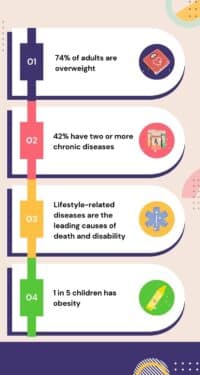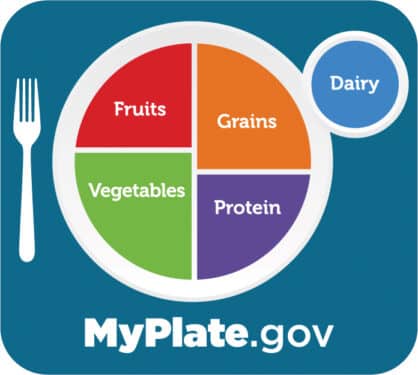How the Dietary Guidelines for America come to be and how they stand to impact Americans’ health
Fact checked by Ros Lederman
Americans have their work cut out for them when it comes to health. The statistics paint a concerning picture, from weight to chronic disease.

Diet plays a key role in these patterns, and since the 1980s, Americans have looked to the Dietary Guidelines for Americans (DGA). The DGA has been foundational for public health education and policy nationwide, providing science-based recommendations for a healthy diet. And a variety of people who educate the public refer to them: government agencies, doctors, dietitians, nurses, and other health professionals.
“The DGAs are based on the totality of the latest research comparing published data on diet, eating habits, food, and nutrient intake — all of which continue to evolve over time,” says Linda Van Horn, PhD, a registered dietitian, professor of preventive medicine, and chief of nutrition research at Northwestern University Feinberg School of Medicine.
Yet, worsening health in the U.S. has led some to question the dietary guidelines. Critics claim they have led to higher rates of obesity and chronic disease, have been politically influenced, and lack transparency.
A closer look at the Dietary Guidelines tells a more complete story. Less than 10% of people report following the DGA, making the guidelines an unlikely culprit in chronic disease rates. In fact, following the guidelines may be part of the solution.
“Americans tend to over-consume salt, sugar, and undesirable fats — particularly found in ultra-processed food — and to under-consume fruits, vegetables, and other produce-type foods.,” Van Horn says.
Yet, research shows that following the dietary guidelines may result in reduced risk for hypertension, cardiovascular disease, type 2 diabetes, and may support overall bone health, says Kevin Pietro, PhD, a registered dietitian nutritionist, assistant professor, and director of Dietetics Education Programs at Loyola University Chicago.
The process behind the guidelines
Every five years, law requires an update of the DGAs. The process starts with an independent, expert committee performing a comprehensive review of the latest research. Committee members are vetted for conflicts of interest and must meet certain pre-established criteria that ensure a balanced board of members.
“The Dietary Guidelines Advisory Committee is made up of nationally recognized experts in the field of nutrition and health,” Van Horn says.
Representatives from the U.S. Department of Agriculture (USDA) and Health and Human Services (HHS) provide support to the independent scientists as they create what’s known as the DGAC scientific report. The committee holds publicly available meetings as they craft the scientific report, and historically, there have been many opportunities for public comments, though HHS under Robert F. Kennedy, Jr. has cut many public comments, claiming they slow down the process.
For the latest DGA report, the public submitted nearly 10,000 comments during the December 2024 to February 2025 comment period. View them at regulations.gov (Docket ID HHS-OASH-2022-0021). An additional 79 speakers made comments at a January 16 virtual meeting open to the public.
The final DGAC scientific report is publicly available and submitted to officials at the USDA and HHS, who use the report and recommendations from the committee to craft the final guidelines.
This comprehensive review process means that as the scientific and medical communities’ knowledge of health and nutrition has grown, the guidelines have adapted. Yet, a common complaint among critics of the DGAs is that the guidelines change over time, which in critics’ view indicates the information is unreliable. This perspective, though, disregards the benefits of the ever-evolving world of health science.
“The original DGAs had a heavy focus on lowering high fat, saturated fat, and sodium consumption,” Van Horn says. “Over time, as more and more research has been published, the DGAs have progressed towards emphasizing the highly significant role of fruits, vegetables, whole grains, and dietary fiber.”
This is an example of the emphasis changing, though the overall information has remained consistent.
“Certain aspects have withstood the test of time,” Pietro says. “These include eating a wide variety of foods, eating more fiber-rich foods, and avoiding excessive amounts of saturated fat.”
Picture a plate

“MyPlate offers individuals a way to organize each meal to align their consumption with the DGAs,” Pietro says. “It includes four food groups arranged on a plate (vegetables, grains, fruits, and protein) and encourages the inclusion of dairy off to the side.”
MyPlate recommends that fruits and vegetables make up half of your plate, with an emphasis on vegetables; one-quarter should be grains with an emphasis on whole grains; and the remaining quarter should be lean protein. Dairy, such as low-fat milk, yogurt, cheese, or fortified soy milk, are on the side.
This simple formula captures much of what the DGAs currently recommend. While there can be many layers and refinements to a healthy diet, for many people, a shift towards meals following the MyPlate formula can significantly impact health.
After all, at its core, the DGAs result from robust scientific research into the dietary, cultural, and environmental factors that influence nutrition and health. They are only as good as the science behind them. Funding quality research ensures that accurate information guides the recommendations.
By providing a science-based foundation for dietary recommendations, the DGAs fill an essential role in public health. How people use the DGAs determines their true impact.

Rebecca is an experienced registered dietitian, freelance writer, and yoga teacher who loves to read, hike, and tend her garden.












